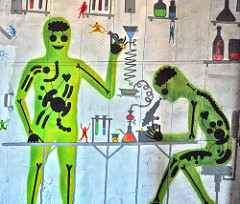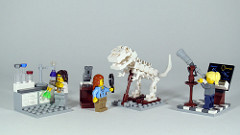How does science get done? In many ways —  experimenting, theorizing, testing, observing. But good science also comes from lots and lots of talking.
experimenting, theorizing, testing, observing. But good science also comes from lots and lots of talking.
At conferences, in journals, in hallways, at seminars, with patients, in classrooms and labs, over coffee, through e-mail and shared citation lists and phone calls.
The “community of scientists” can be very much like a family — you work together for a while before some family members go to other places and work with other scientists; some members of the family support you while others stop speaking to you; and so forth.
 There are many accounts of life in labs and in the field, in hospitals, at universities, and at companies, which weave the stories of how scientists communicate, discover and observe, communicate some more, and keep building on what they’ve learned, both on their own and from others.
There are many accounts of life in labs and in the field, in hospitals, at universities, and at companies, which weave the stories of how scientists communicate, discover and observe, communicate some more, and keep building on what they’ve learned, both on their own and from others.
Read the inside stories about how science gets done in these engrossing tales:
- Oliver Sacks was the neurologist who wrote The Man Who Mistook His Wife for a Hat and Awakenings (here’s the DVD, too). He gave the world a last gift with his totally honest autobiography, On the Move, published in 2015 a few months before he died.
- The Double Helix: a Personal Account of the Discovery of the Structure of DNA is the gossipy “inside” story about one of the most important discoveries in history, written by James Watson in 1968. (But, as with families, there are differing viewpoints.)
 Jonathan Beckwith has been at Harvard since 1965, and has been immersed in the world of molecular biology for much of his life. His fascinating autobiography, Making Genes, Making Waves: a Social Activist in Science, talks about being an eminent scientist as well as an activist, and illustrates the rich communities of science in which he has spent his life.
Jonathan Beckwith has been at Harvard since 1965, and has been immersed in the world of molecular biology for much of his life. His fascinating autobiography, Making Genes, Making Waves: a Social Activist in Science, talks about being an eminent scientist as well as an activist, and illustrates the rich communities of science in which he has spent his life.
For more of the “inside stories” about how science gets done, you should also read Hidden Figures: the American Dream and the Untold Story of the Black Women Mathematicians Who Helped Win the Space Race (the movie based on the book is in theaters now) and The Glass Universe: How the Ladies of the Harvard Observatory Took the Measure of the Stars.
